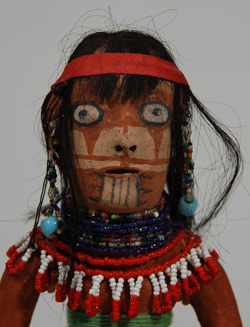Historic Mojave Clay Doll Figurine [SOLD]
+ Add to my watchlist Forward to Friend
- Category: Historic
- Origin: Mojave Tribe
- Medium: clay, paint, fabric, beads
- Size: 9-3/4” tall
- Item # 25599 SOLD
 The land of the Mojave, the most northern of the Yuman tribes, stretched from Black Canyon to the Picacho Mountains below today's Parker Dam (California and Arizona border), straddling the Colorado River.
The land of the Mojave, the most northern of the Yuman tribes, stretched from Black Canyon to the Picacho Mountains below today's Parker Dam (California and Arizona border), straddling the Colorado River.
The Mojave could be a fierce people willing to protect their land, and willing to venture far from it. They traveled to the Pacific Coast, becoming proficient traders. They exchanged with coastal tribes surplus crops for goods they desired and valued, such as shells.
And back at home along the banks of the river, they made pottery from sedimentary clay and crushed sandstone. The material was coiled into shape, dried, painted and fired in either open pits or rudimentary kilns. They created pots, bowls, ladles and dishes decorated with geometric designs. And the women took the crafts further by making unique pottery dolls for the children, dressing and decorating them like people, complete with human hair. The art of tattoo was important to the Mojave. They tattooed their faces with lines and dots—a cosmetic, fashionable practice.
The women decorated the faces of the dolls with traditional tattoo patterns worn by the adults. They dressed them in traditional clothing including elaborate earrings and beadwork, as illustrated in this one. A metal stand has been manufactured for secure display of the doll.
Condition: really in very good condition with some fading of the purple skirt but nothing else of significance.
Provenance: from the collection of Chuck and Jan Rosenak, renowned collectors and authors of Navajo Folk Art.
Recommended Reading: Mojave Pottery, Mojave People: The Dillingham Collection of Mojave Ceramics by Jill Furst
- Category: Historic
- Origin: Mojave Tribe
- Medium: clay, paint, fabric, beads
- Size: 9-3/4” tall
- Item # 25599 SOLD



